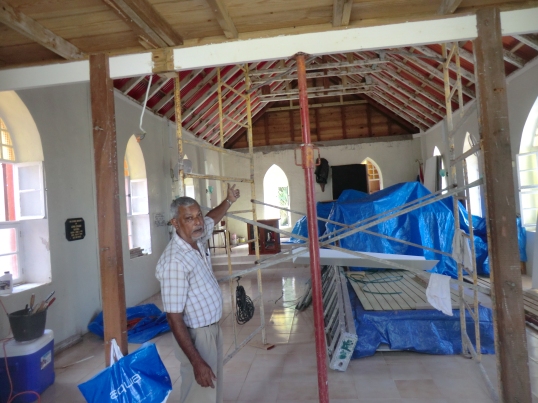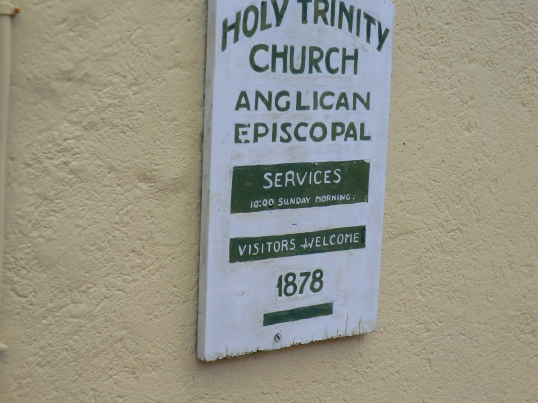A DOG CALLED MIKE

Ambrose Johnson here with Mike behind him.
A DOG CALLED MIKE
By; Will Johnson
I recently came across a photo of preparations in the Windward Side for Ronny Johnson’s newly built boat to be launched at the Fort Bay. It was taken by Father Bruno Boradori in the early nineteen sixties.
Among the photos of the launching of the boat there was one with Benjamin Ambrose Johnson (Gilly) with a black dog by his side. I realized that the dog had to be the famous dog called Mike. I went back in my old Saba Herald’s and in the edition of Monday October 28th 1968 I found what I was looking for.
The article was written by William Carl Anslyn. He was from Saba and had served on Aruba as a Senator for seven years and also as a Commissioner for five years as well. He returned to Saba when he was in his fifties. Here his brother John Arthur Anslyn had also served this island for sixteen years as a Commissioner and a Member of the Island Council.
Carl helped me for a while as the Editor of The Saba Herald but we fell out after a short while as his politics and mine, to say it mildly, were different. In the end after many battles and verbal abuse he somehow decided to support me and did so until he died. He returned to Aruba when he had passed eighty and died there and is buried there as well.

Carl Anslyn here feeding his chickens on the Scjotsenhoek plantation on Statia which he and his brother Arthur used to own.
He was a talented writer, especially of political pamphlets, of which I bore the brunt of the blows in his political pamphlet called ‘The Bull’s Eye’. He also wrote a small book of his years as a teenager growing up in the Windward Side.
To give you a sample of his skills to properly alarm people on Saba as to my ambitions in the 1969 elections, he would warn the people of Saba to beware of me and my intentions towards the hard working people of Saba. Although I was running with the U.R.A. party at the time he aligned me in his propaganda with the Frente Obrero the party of Wilson ‘Papa” Godet and Stanley Brown. The latter party was formed after the uprising on Curacao on May 30th 1969 which resulted in the burning of much of the city of Willemstad.
Carl would warn people that I did not have a house nor lived on Saba that my only intention was to burn the place down. With some 80% of the houses on the island being built from wood the threat of fire was one way to get voters’ attention. He even listed a number of young people who had built houses to fear the worst as I envied them and wanted to burn down their newly built homes. Even though these modern homes were built from cement there seemed to still be reason for fear. One of these young people even approached me and asked me what he had done to me to warrant me to want to burn down his newly built home. Carl was not easy believe me.
Then the rebel himself, ‘Arsonist in Chief’ Sanely Brown during the campaign showed up on Saba to support me. I was from another political party and living on St. Maarten. No matter. I was not a threat to Stanley’s ‘Frente Obrero’ on Curacao and so he thought it would be of some help to me to visit Saba and support me. Too bad in the night it was claimed that he was shouting out ‘Burn Baby Burn!’

Ambrose Johnson here with teacher Gladys Hassell.
Carl’s stencil machine went into overdrive the night of Stanley’s visit. A pamphlet came out giving instructions to people to purchase fire buckets, extra rope, ladders and so on once again informing people that I had gone into politics with the sole intention to burn the place down. That kind of writer he was. An alarmist of the first order and a political opponent to be reckoned with.
But in his story about Gilly’s dog Mike he shows a different kind of skill and is a pleasure to read.
I experienced Mike once on a visit to Saba with friends from St. Maarten. He had just come down from the Mountain with a group of tourists. He was lying in front of the Police Station where ‘Gilly’ worked as a telephone operator. When he heard us talking about going up the mountain he promptly revved up and accompanied us the way up to the top and back down.
And now to Carl’s interesting story of the remarkable dog Mike who once graced the streets of Windward Side giving visitors to the island a tour whether they wanted one or not.
“Mike is a part-breed Labrador Retriever which to the casual observer shows no more distinguishing features than those shown by any big and friendly dog. Looking at Mike one would hardly think that he’s an intellectual, a prince among dogs! For Mike, besides being a gentleman, is Saba’s unofficial tourist guide!
From the porch of the Post office building where his master works in the Telephone Exchange, Mike regards the passing world with seemingly sleepy eyes. Let a vehicle disgorge Saban passengers in front the building, Mike, as far as interest is concerned, could be blissfully asleep on Mars. Let a Jeep arrive with tourists, and Mike is in their midst before their feet touch the pavement. After properly introducing himself in a gentlemanly manner by quietly sniffing each of the arrivals, he will turn his attention to the business of the day, accompanying his guests around the town, and leading them to the main points of interest.

Algernon Hassell, Carl Hassell and Mr Harold Johnson here cooling out where Mike had his headquarters.
Once his job is done and the usual rounds have been made he will take off and attach himself to another group, and repeat the procedure. At the end of a busy day, and a job well done, he returns to his home and begins his wait for another day and another group of arrivals.
Often a solitary visitor to the island, drifting around and wondering where to go and what to do, will feel his leg nudged and will look down to see a black dog loping along at his side, and leading the way with occasional backward glances to assure himself that the visitor has got the point! One such visitor, a young Hungarian, decided on a fine morning that he was going to walk from the Windward Side to the airport. This is a walk which any Saban would hesitate before attempting, but our friend left the Guesthouse in fine spirits. By the Post Office he was joined by Mike, who duly inspected and accepted him, and proceeded him to the airport. In due time Mike delivered him back to the Guesthouse, nudged his leg as a farewell salute to a job well done, and returned to the Post Office porch. As the visitor afterwards remarked, ‘How is it possible? He went before me all the way. I didn’t show him where to go, and I couldn’t tell him. How does he do it, is what more than one person asked themselves, and the answer is still a big question mark.
On a bright and sunny day two elderly American ladies were walking around the Windward Side, accompanied by Mike. One of them, being a bit talkative, stopped several persons and asked questions about the island. In the beginning Mike was very tolerant but as time went by there were too many stops and too much talking. Mike who must have had a pretty tight work schedule that day, decided to put a stop to the dalliance once and for all. The lady was once more deep in talk when she felt her hand practically being swallowed by Mike, his face the picture of disgust, dragging her from the scene. As the lady remarked later;” It was an experience I wouldn’t have missed for anything.”
Mike’s exploits are legendary in Saba, and already some of our good citizens have suggested that he be given the official title “Ambassador of Goodwill and Unofficial Tourist Guide.”

The old Post Office, Police Station and Telephone Exchange where Mike used to hang out. This photo is from the collection of Dr. Julia Crane of young people picking up packages on a day which the mail boat was in. 1964
He is one of the simple things, the unique things, which makes Saba an interesting place to visit. He is only a dog, yet he has caused more pleasure, and done more to make Saba interesting to its visitors, than many a well-meaning citizen. We would not be surprised some day to see a statue of Mike in our town, adorned with the inscription: “He was only a dog, but he did his part.”
We must thank Mr. Anslyn for this wonderful story about Mike. And we cannot end the story without mentioning how Anslyn’s pamphleteering was not as successful of that of Thomas Paine in the revolution of the North American colonies. Mr. Carl Hassell (‘Sheddy’) came to my rescue in the end. A bunch of people were drinking in his shop and crying shame on me for wanting to burn down the place. Mr. Carl asked them ‘Pray tell me where is Anslyn’s home?’ Fact is that he did not have one and was living with an old cousin of his. And so the constant reference to the fact that I did not have a house did not have much effect anymore and that was the end of the story. Good memories though and I have those pamphlets still on file somewhere. But you must admit that Carl did a good job on preserving the story of Mike the unusual dog which lived among us on Saba. Enjoy the story of Mike the dog!









 The Church of England had 1500 members on Saba in 1874. However, with the establishment of the Roman Catholic Church on Saba in 1860 the numbers declined. In 1877 there were 1458 Anglicans on Saba out of a total population of 2072.The Anglican Church has lost its dominant position over the years since then, however the church still carries on and the remaining members of the church are as dedicated to their church as those who in 1763 got together to pay a salary to the Reverend Richard Davis, and may God continue to bless their work on Saba.
The Church of England had 1500 members on Saba in 1874. However, with the establishment of the Roman Catholic Church on Saba in 1860 the numbers declined. In 1877 there were 1458 Anglicans on Saba out of a total population of 2072.The Anglican Church has lost its dominant position over the years since then, however the church still carries on and the remaining members of the church are as dedicated to their church as those who in 1763 got together to pay a salary to the Reverend Richard Davis, and may God continue to bless their work on Saba.